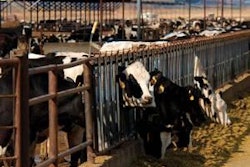Vacuum infusion is the application of liquid fats or oils to dry extruded feeds under negative air pressure. During the vacuum cycle, air is removed from the vacuum chamber or vesselusually a type of mixerand from the extruded product inside the chamber. The vacuum extends into the void spaces within the pellet or kibble. Then atomized liquid enters the chamber and the vacuum is released, allowing air pressure to rise. The return to atmospheric pressure in the chamber forces the liquid throughout the interior voids of the product, coating interior surfaces, thereby infusing the feed.
Infusion or core-coating' with oil incorporates a highly palatable, concentrated source of energy in the ration, increasing the diet's potential to support animal growth or activity. Also, however, the technique enables the oil or other infused liquid to serve as a carrier for micro ingredients. Infused micros could include almost any ingredients subject to degradation by the high temperature and pressures of steam-injected conditioning or expander or extrusion processingmedicated products, pigments, vitamins, direct-fed microbials, enzymes, etc.
The principal of vacuum oil infusion is simple, but in practice requires proper equipment and controlled operation. The equipment and expertise are increasingly common in aquafeed plantsparticularly those making products for carnivorous fish like salmon and troutas well as in a growing number of petfood plants. However, the technique is not yet widespread in full-range feed plants, although there are opportunities for application in a variety of specialty feed products.
Salmon feed example
Vacuum infusion of marine or vegetable oils into extruded salmon feeds serves as a useful model to understanding the technology, its potential applications, and its limitations for infusion of oil-suspension premixes, liquid ingredient blends, and co-infusion of possibly antagonistic micro ingredients. The technology, although still relatively new, is well past its infancy and now is undergoing fine-tuning by private companies and universities, including Texas A&M University. Each year, the Extrusion Technology Program in TAMU's Food Protein R&D Center on the College Station campus conducts an intensive aquafeed formulation and manufacturing short course which covers vacuum infusion of aquafeeds (see www.tamu.edu/extrusion).
It is important to keep in mind that vacuum infusion can only be part of the complete feed manufacturing process, which relies on quality production from selection of raw materials, formulation, grinding, extrusion, expansion, drying, cooling, temperature, moisture content, and product conveying. The watchwords are: "Quality in, quality out."
Pre-infusion processing
For example, both experimentation and operational experience demonstrate that grinding has a major effect on extruded pellets in terms of structural quality, which can ultimately affect vacuum infusion. In the case of salmon feeds, hammer milling remains the most common particle reduction technique, in which the rule of thumb for such feeds is the finer the grind the better'. Pellet durability increases with uniform fine-grinding of these high-protein formulations. Finer-ground proteins bind more readily and finer-ground starches gelatinize more easily. Uniform fine-grinding of materials to 70% particle sizes under 0.25 mm and 100% particle sizes under 0.4 mm generally results in acceptable-quality to good-quality extruded salmon feed products.
Uniformity in extruded pellets contributes to effective vacuum infusion. Product uniformity requires use of quality steam conditioning or pre-conditioning' equipment and extrusion equipment, operated properly. Thorough pre-conditioning, with feed mash retention in the range of 23 minutes helps to ensure maximum gelatinization of starches during the extrusion process. Poorly extruded products can vary in uniformity of size and structural integrity, resulting in a product that will not dry evenly, will fracture easily, will not absorb liquids and micros uniformly, and will be more likely to have a poor overall appearance.
Extruded pellets expand as they discharge from the extruder and are released to atmospheric pressure. Expansion is critical to vacuum infusion and must be controlled to produce pellets with the desired characteristics needed to allow for the right amount of void or free area within the pellet in order to absorb the total required oil as formulated in the diet.
Controlled expansion critical for micros
Controlled expansion may be even more critical to achieving a quality product when micro ingredients are blended or suspended in the oil or other liquid carrier for vacuum infusion, or separately co-infused. It is reasonable to expect that the co-efficient of variation for vacuum-infused micro ingredients would be higher, given greater variability in product expansion.
Certainly, well-designed and accurately expanded feeds are essential to provide a balanced, slow-sinking salmon feed. Over-expanded' feeds tend to be more fragile. Over-expanded feeds also can floateven after vacuum infusiondue to too low bulk density.
By contrast, under-expanded' feeds cannot absorb the total amount of oil formulated in the diet. Also, they are physically harder and generally sink faster due to higher bulk density. Under-expanded, higher-density feeds do not dry down as readily as feeds that have received adequate expansion. After vacuum infusion, these denser feeds may appear oily or wet. If they are carrying micros, too, these expensive ingredients would be wasted.
Drying must be uniform from pellet to pellet, in order to provide a balanced diet. As an industry rule of thumb, variations in moisture from pellet to pellet greater than 1.01.5% are considered below modern industry drying standards. Good practice indicates that the dryer be capable of drying all that the extruder can produce, with a little extra capacity on-hand.
On average, high-quality salmon feeds are dried to a range of 69%. The dryer must be guaranteed to meet all drying requirements at the required capacities. Too-small a dryer causes problems in uniform drying, meeting moisture targets, complete vacuum infusion of liquids as formulated, and ultimately product appearance and nutritional quality.
Drying, cooling, then vacuum infusion
Cooling after drying improves feed quality and reduces the amount of moisture vaporization within the vacuum chamber during the vacuum cycle. Feed quality is improved due in part to an increase in pellet durability resulting from the curing or hardening of the starch and other binding components of the formula. After cooling, the more durable feed can better withstand the rigors of conveying and oil addition, including treatment in the vacuum mixer.
Before the introduction of vacuum infusion technology, the production of high-fat feeds required the feed to be hot off the dryer going into the fat application stage. With the application of hot oil, the hot feed was able to absorb more oil than was the case for cooled feeds. However, with the advent of vacuum infusion, hot feed was not required to attain maximum oil inclusion.
Using cooled feed for vacuum infusion also offers many other benefits. For example, if hot oil is infused into hot feed, it can readily vaporize volatile ingredients or leak out of the feed during the early stages of cooling. This effect results in wasted ingredients and messy process equipment and plant floors, and causes greater nutrient variability in the final feed product. Moreover, hot oil oxidizes more rapidly than oil infused at more moderate temperatures, which also can reduce product quality.
Ideally, the feed going into vacuum infusion is cool and the oil temperature is only high enough to accommodate flowability and mixing into solution of any additives. Then there is less possibility of liquids flashing off or leaking out. Also, use of more moderate oil temperature increases the range of micro ingredients that may be blended with the oil in a premix prior to infusion. In practice, the use of oil at temperatures marginally higher than the dry cool feed being infused helps to reduce oil leakage downstream from vacuum infusion. Use of ideal temperatures of oil and feed may allow the oil to thicken in the pellets before they arrive in the cooler, thus avoiding any losses.
The moisture content of feed to be vacuum-infused is important, also. Too-high moisture results in moisture evaporation within the vacuum chamber, which reduces vacuum efficiency. When liquid water changes state from a liquid to a gas, it occupies roughly 1,600 times its original volume at atmospheric pressure and even greater volume under vacuum. As the liquid vaporizes, thereby occupying space within the chamber, the vacuum pump works to remove the vapor, trying to achieve the targeted pressure set point. Thus, the greater the available moisture in the product, the longer or harder the vacuum pump must work. Although vacuum drying-cooling is used for specialized products in the human food industry, its use in feed production likely would be prohibitive in terms of capital cost and vacuum cycle operation time.
Vacuum infusion is highly predictable when it follows accurately controlled pre-conditioning, extrusion, drying, and cooling. The result is optimal feed quality. Under well-controlled conditions, it is much easier to experiment with liquid micro ingredients and exploit the advantages of vacuum infusion. One such advantage is the reduction or elimination of the waste of expensive micro ingredients. However, perhaps even more important for leading-edge products, is the physical protection afforded by vacuum infusion, in which fragile micro ingredients permeate the pellet and are not simply applied' to the outside.



.jpg?auto=format%2Ccompress&fit=crop&h=167&q=70&w=250)













